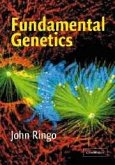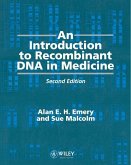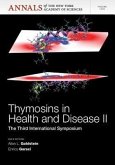- Gebundenes Buch
- Merkliste
- Auf die Merkliste
- Bewerten Bewerten
- Teilen
- Produkt teilen
- Produkterinnerung
- Produkterinnerung
An outstanding group of scientists have collaborated in the collection of case studies that comprise this major text-reference book. It examines in detail how genes operate in diverse living systems, including viruses, cells and more complex organisms; investigates how genotypes can be altered; and looks at the mapping and sequencing of human and other genomes. Students and professionals in biochemistry, molecular biology and genetics will enjoy this book.
Andere Kunden interessierten sich auch für
![Fundamental Genetics Fundamental Genetics]() John RingoFundamental Genetics203,99 €
John RingoFundamental Genetics203,99 €![Symposium Volume 80: 21st Century Genetics Symposium Volume 80: 21st Century Genetics]() Symposium Volume 80: 21st Century Genetics220,99 €
Symposium Volume 80: 21st Century Genetics220,99 €![An Introduction to Recombinant DNA in Medicine An Introduction to Recombinant DNA in Medicine]() Alan E H EmeryAn Introduction to Recombinant DNA in Medicine145,99 €
Alan E H EmeryAn Introduction to Recombinant DNA in Medicine145,99 €![Phenomics Phenomics]() Phenomics232,99 €
Phenomics232,99 €![Thymosins in Health and Disease II Thymosins in Health and Disease II]() Thymosins in Health and Disease II75,99 €
Thymosins in Health and Disease II75,99 €![Genetic Analysis Genetic Analysis]() FinchamGenetic Analysis92,99 €
FinchamGenetic Analysis92,99 €![Genome, Transcriptome and Proteome Analysis Genome, Transcriptome and Proteome Analysis]() Alain BernotGenome, Transcriptome and Proteome Analysis88,99 €
Alain BernotGenome, Transcriptome and Proteome Analysis88,99 €-
-
-
An outstanding group of scientists have collaborated in the collection of case studies that comprise this major text-reference book. It examines in detail how genes operate in diverse living systems, including viruses, cells and more complex organisms; investigates how genotypes can be altered; and looks at the mapping and sequencing of human and other genomes. Students and professionals in biochemistry, molecular biology and genetics will enjoy this book.
Produktdetails
- Produktdetails
- Verlag: MIT Press / University Science Books
- Seitenzahl: 674
- Erscheinungstermin: 7. Mai 1997
- Englisch
- Abmessung: 286mm x 226mm x 40mm
- Gewicht: 1932g
- ISBN-13: 9780935702705
- ISBN-10: 0935702709
- Artikelnr.: 21594112
- Herstellerkennzeichnung
- Libri GmbH
- Europaallee 1
- 36244 Bad Hersfeld
- gpsr@libri.de
- Verlag: MIT Press / University Science Books
- Seitenzahl: 674
- Erscheinungstermin: 7. Mai 1997
- Englisch
- Abmessung: 286mm x 226mm x 40mm
- Gewicht: 1932g
- ISBN-13: 9780935702705
- ISBN-10: 0935702709
- Artikelnr.: 21594112
- Herstellerkennzeichnung
- Libri GmbH
- Europaallee 1
- 36244 Bad Hersfeld
- gpsr@libri.de
Maxine Singer (Author) Maxine Singer is the President of the Carnegie Institution of Washington and Scientist Emeritus at the NIH where she conducts research on transposable elements in the human genome. She is a member of the US National Academy of Sciences and its Institute of Medicine, and was awarded the National Medal of Science in 1992.Paul Berg (Author) Paul Berg is Willson Professor of Biochemistry and Director of the Beckman Center for Molecular and Genetic Medicine, Stanford University School of Medicine. He is a member of the US National Academy of Sciences and its Institute of Medicine. He was awarded the Nobel Prize in Chemistry in 1980, and received the National Medal of Science in 1983.
1. Mammalian DNA Viruses: Papovaviruses as Models of Cellular Genetic
Functions and Oncogenesis, Paul Berg & Maxine Singer
1.1 Introduction
1.2 General Features of Mammalian DNA Viruses
1.3 SV40: The Best Understood Papovavirus
1.4 Other Papovaviruses
1.5 Comparative Strategies for Cellular Activation by Papova- and
Adenoviruses
1.6 Conclusion
2. Eukaryotic RNA Viruses: A Variant Genetic System, Ellen G. Strauss and
James H. Strauss
2.1 Replication Strategies of Eukaryotic RNA Viruses
2.2 Plus-Strand RNA Virus Genomes
2.3 Minus-Strand RNA Virus Genomes
2.4 Double-Strand RNA Virus Genomes
2.5 Manipulation of Cloned Viral Genomes
2.6 “Infectious Clones” and the Genetic Revolution
2.7 RNA Viruses as Vectors
2.8 Conclusion
3. Retroviruses: Infectious Genetic Elements, Stephen P. Goff
3.1 Introduction
3.2 The Replication-Competent Retroviruses: Practically Perfect Parasites
3.3 Genetic Analysis of Retroviral Replication Functions
3.4 Replication-Defective Transforming Viruses
3.5 Human Retroviruses
3.6 Gene Transfer and Gene Therapy
3.7 Conclusion
4. Oncogenes, Growth Suppressor Genes,and Cancer, Tony H unter
4.1 Oncogenes
4.2 The Functions of Oncogene Products
4.3 DNA Tumor Virus Oncoproteins and the Cell Cycle
4.4 Growth Suppressor Proteins
4.5 Cooperation Between Genetic Events in Tumorigenesis
4.6 Tumorigenesis in Humans
4.7 Viruses and Human Cancer
4.8 Conclusions and Prospects
5. Mapping Markers and Genes in the Human Genome, Ray White
5.1 Introduction
5.2 Variations in DNA Sequence: The New Genetic Markers
5.3 Analysis of Genetic Linkage in Humans
5.4 Linkage Maps of Human Chromosomes
5.5 Mapping and Isolating Genes Responsible for Human Diseases
5.6 DNA Sequence Variations as Markers in Somatic Cells
5.7 Conclusion: Genetics and Human Variation
6. Molecular Genetics of the Hemoglobin Genes, Haig H. Kazazian, Jr., and
Stylianos Antonarakis
6.1 The Globin Genes and Proteins
6.2 Expression of Globin Genes
6.3 Molecular Basis of Hemoglobinophathies
6.4 DNA Polymorphisms in the Globin Gene Cluster and Their Use in Analysis
of Disease-Producing Mutations
7. Generation of Antigen Receptor Diversity, Jianzhu Chen and Frederick W.
Alt
7.1 Overview of the Immune System
7.2 Cell and Animal Models to Study B Cell Differentiation
7.3 Organization and Expression of Ig Genes
7.4 Mechanism of Antigen Receptor Variable Region Gene Assembly
7.5 Control of V(D)J Recombination
7.6 Modification of the Primary B Cell Antibody Repertoire
7.7 Conclusion
8. Biosynthesis of Intercellular Messenger Peptides, Maxine Singer and Paul
Berg
8.1 The Special Properties of Intercellular Messenger Peptides and Their
Genes
8.2 The Biochemistry of Cotranslational and Posttranslational Modifications
and Proteolytic Processing
8.3 The Secretory Pathway
8.4 The alpha-Pheromone of Saccharomyces cerevisiae
8.5 Insulin: One Gene, Two Polypeptides, One Protein
8.6 Multiple Active Peptides from Single Genes by Differential
Posttranslational Processing
8.7 Multiple Active Peptides from a Single Gene by Alternative Splicing:
Calcitonin and CGRP
8.8 Messenger Peptides and Fixed Behavioral Patterns in Aplysia
8.9 Comments
9. Regulation of Early Drosophila Development by Transcription Factors and
Cell-Cell Signaling, Thomas B. Kornberg and Matthew P. Scott
9.1 The Development Program of Drosophila
9.2 Maternal Influences on Developmental Events
9.3 Anterior-Posterior Patterning
9.4 The Roles of Transcription Factors in Early Development
9.5 Moleuclar Methods in Drosophila Developmental Genetics
9.6 Perspectives
10. Manipulating Protein Structure, Cynthia N. Kiser and John H. Richards
10.1 General Considerations
10.2 Protein Folding and Stability
10.3 Protein Function
11. Genetic Modification of Animals, Tim Stewart
11.1 Genetically Modified Rodents as an Experimental Tood
11.2 Transcription
11.3 Growth and Development
11.4 Immunology
11.5 Oncogenesis
11.6 Mutations
11.7 Models of Human Diseases
12. Genetic Modification of Plants, Patricia Zambryski
12.1 Agrobacterium-Plant Cell Interaction: General Concepts
12.2 Activation and Expression of Virulence Genes
12.3 DNA Transfer
12.4 Crown Gall Tumor
12.5 Ti-Plasmid as a Vector for Gene Transfer to Platns
12.6 Arabidopsis thaliana, a Model Plant System
12.7 Evolutionary Considerations and Floral Development
Index
Functions and Oncogenesis, Paul Berg & Maxine Singer
1.1 Introduction
1.2 General Features of Mammalian DNA Viruses
1.3 SV40: The Best Understood Papovavirus
1.4 Other Papovaviruses
1.5 Comparative Strategies for Cellular Activation by Papova- and
Adenoviruses
1.6 Conclusion
2. Eukaryotic RNA Viruses: A Variant Genetic System, Ellen G. Strauss and
James H. Strauss
2.1 Replication Strategies of Eukaryotic RNA Viruses
2.2 Plus-Strand RNA Virus Genomes
2.3 Minus-Strand RNA Virus Genomes
2.4 Double-Strand RNA Virus Genomes
2.5 Manipulation of Cloned Viral Genomes
2.6 “Infectious Clones” and the Genetic Revolution
2.7 RNA Viruses as Vectors
2.8 Conclusion
3. Retroviruses: Infectious Genetic Elements, Stephen P. Goff
3.1 Introduction
3.2 The Replication-Competent Retroviruses: Practically Perfect Parasites
3.3 Genetic Analysis of Retroviral Replication Functions
3.4 Replication-Defective Transforming Viruses
3.5 Human Retroviruses
3.6 Gene Transfer and Gene Therapy
3.7 Conclusion
4. Oncogenes, Growth Suppressor Genes,and Cancer, Tony H unter
4.1 Oncogenes
4.2 The Functions of Oncogene Products
4.3 DNA Tumor Virus Oncoproteins and the Cell Cycle
4.4 Growth Suppressor Proteins
4.5 Cooperation Between Genetic Events in Tumorigenesis
4.6 Tumorigenesis in Humans
4.7 Viruses and Human Cancer
4.8 Conclusions and Prospects
5. Mapping Markers and Genes in the Human Genome, Ray White
5.1 Introduction
5.2 Variations in DNA Sequence: The New Genetic Markers
5.3 Analysis of Genetic Linkage in Humans
5.4 Linkage Maps of Human Chromosomes
5.5 Mapping and Isolating Genes Responsible for Human Diseases
5.6 DNA Sequence Variations as Markers in Somatic Cells
5.7 Conclusion: Genetics and Human Variation
6. Molecular Genetics of the Hemoglobin Genes, Haig H. Kazazian, Jr., and
Stylianos Antonarakis
6.1 The Globin Genes and Proteins
6.2 Expression of Globin Genes
6.3 Molecular Basis of Hemoglobinophathies
6.4 DNA Polymorphisms in the Globin Gene Cluster and Their Use in Analysis
of Disease-Producing Mutations
7. Generation of Antigen Receptor Diversity, Jianzhu Chen and Frederick W.
Alt
7.1 Overview of the Immune System
7.2 Cell and Animal Models to Study B Cell Differentiation
7.3 Organization and Expression of Ig Genes
7.4 Mechanism of Antigen Receptor Variable Region Gene Assembly
7.5 Control of V(D)J Recombination
7.6 Modification of the Primary B Cell Antibody Repertoire
7.7 Conclusion
8. Biosynthesis of Intercellular Messenger Peptides, Maxine Singer and Paul
Berg
8.1 The Special Properties of Intercellular Messenger Peptides and Their
Genes
8.2 The Biochemistry of Cotranslational and Posttranslational Modifications
and Proteolytic Processing
8.3 The Secretory Pathway
8.4 The alpha-Pheromone of Saccharomyces cerevisiae
8.5 Insulin: One Gene, Two Polypeptides, One Protein
8.6 Multiple Active Peptides from Single Genes by Differential
Posttranslational Processing
8.7 Multiple Active Peptides from a Single Gene by Alternative Splicing:
Calcitonin and CGRP
8.8 Messenger Peptides and Fixed Behavioral Patterns in Aplysia
8.9 Comments
9. Regulation of Early Drosophila Development by Transcription Factors and
Cell-Cell Signaling, Thomas B. Kornberg and Matthew P. Scott
9.1 The Development Program of Drosophila
9.2 Maternal Influences on Developmental Events
9.3 Anterior-Posterior Patterning
9.4 The Roles of Transcription Factors in Early Development
9.5 Moleuclar Methods in Drosophila Developmental Genetics
9.6 Perspectives
10. Manipulating Protein Structure, Cynthia N. Kiser and John H. Richards
10.1 General Considerations
10.2 Protein Folding and Stability
10.3 Protein Function
11. Genetic Modification of Animals, Tim Stewart
11.1 Genetically Modified Rodents as an Experimental Tood
11.2 Transcription
11.3 Growth and Development
11.4 Immunology
11.5 Oncogenesis
11.6 Mutations
11.7 Models of Human Diseases
12. Genetic Modification of Plants, Patricia Zambryski
12.1 Agrobacterium-Plant Cell Interaction: General Concepts
12.2 Activation and Expression of Virulence Genes
12.3 DNA Transfer
12.4 Crown Gall Tumor
12.5 Ti-Plasmid as a Vector for Gene Transfer to Platns
12.6 Arabidopsis thaliana, a Model Plant System
12.7 Evolutionary Considerations and Floral Development
Index
1. Mammalian DNA Viruses: Papovaviruses as Models of Cellular Genetic
Functions and Oncogenesis, Paul Berg & Maxine Singer
1.1 Introduction
1.2 General Features of Mammalian DNA Viruses
1.3 SV40: The Best Understood Papovavirus
1.4 Other Papovaviruses
1.5 Comparative Strategies for Cellular Activation by Papova- and
Adenoviruses
1.6 Conclusion
2. Eukaryotic RNA Viruses: A Variant Genetic System, Ellen G. Strauss and
James H. Strauss
2.1 Replication Strategies of Eukaryotic RNA Viruses
2.2 Plus-Strand RNA Virus Genomes
2.3 Minus-Strand RNA Virus Genomes
2.4 Double-Strand RNA Virus Genomes
2.5 Manipulation of Cloned Viral Genomes
2.6 “Infectious Clones” and the Genetic Revolution
2.7 RNA Viruses as Vectors
2.8 Conclusion
3. Retroviruses: Infectious Genetic Elements, Stephen P. Goff
3.1 Introduction
3.2 The Replication-Competent Retroviruses: Practically Perfect Parasites
3.3 Genetic Analysis of Retroviral Replication Functions
3.4 Replication-Defective Transforming Viruses
3.5 Human Retroviruses
3.6 Gene Transfer and Gene Therapy
3.7 Conclusion
4. Oncogenes, Growth Suppressor Genes,and Cancer, Tony H unter
4.1 Oncogenes
4.2 The Functions of Oncogene Products
4.3 DNA Tumor Virus Oncoproteins and the Cell Cycle
4.4 Growth Suppressor Proteins
4.5 Cooperation Between Genetic Events in Tumorigenesis
4.6 Tumorigenesis in Humans
4.7 Viruses and Human Cancer
4.8 Conclusions and Prospects
5. Mapping Markers and Genes in the Human Genome, Ray White
5.1 Introduction
5.2 Variations in DNA Sequence: The New Genetic Markers
5.3 Analysis of Genetic Linkage in Humans
5.4 Linkage Maps of Human Chromosomes
5.5 Mapping and Isolating Genes Responsible for Human Diseases
5.6 DNA Sequence Variations as Markers in Somatic Cells
5.7 Conclusion: Genetics and Human Variation
6. Molecular Genetics of the Hemoglobin Genes, Haig H. Kazazian, Jr., and
Stylianos Antonarakis
6.1 The Globin Genes and Proteins
6.2 Expression of Globin Genes
6.3 Molecular Basis of Hemoglobinophathies
6.4 DNA Polymorphisms in the Globin Gene Cluster and Their Use in Analysis
of Disease-Producing Mutations
7. Generation of Antigen Receptor Diversity, Jianzhu Chen and Frederick W.
Alt
7.1 Overview of the Immune System
7.2 Cell and Animal Models to Study B Cell Differentiation
7.3 Organization and Expression of Ig Genes
7.4 Mechanism of Antigen Receptor Variable Region Gene Assembly
7.5 Control of V(D)J Recombination
7.6 Modification of the Primary B Cell Antibody Repertoire
7.7 Conclusion
8. Biosynthesis of Intercellular Messenger Peptides, Maxine Singer and Paul
Berg
8.1 The Special Properties of Intercellular Messenger Peptides and Their
Genes
8.2 The Biochemistry of Cotranslational and Posttranslational Modifications
and Proteolytic Processing
8.3 The Secretory Pathway
8.4 The alpha-Pheromone of Saccharomyces cerevisiae
8.5 Insulin: One Gene, Two Polypeptides, One Protein
8.6 Multiple Active Peptides from Single Genes by Differential
Posttranslational Processing
8.7 Multiple Active Peptides from a Single Gene by Alternative Splicing:
Calcitonin and CGRP
8.8 Messenger Peptides and Fixed Behavioral Patterns in Aplysia
8.9 Comments
9. Regulation of Early Drosophila Development by Transcription Factors and
Cell-Cell Signaling, Thomas B. Kornberg and Matthew P. Scott
9.1 The Development Program of Drosophila
9.2 Maternal Influences on Developmental Events
9.3 Anterior-Posterior Patterning
9.4 The Roles of Transcription Factors in Early Development
9.5 Moleuclar Methods in Drosophila Developmental Genetics
9.6 Perspectives
10. Manipulating Protein Structure, Cynthia N. Kiser and John H. Richards
10.1 General Considerations
10.2 Protein Folding and Stability
10.3 Protein Function
11. Genetic Modification of Animals, Tim Stewart
11.1 Genetically Modified Rodents as an Experimental Tood
11.2 Transcription
11.3 Growth and Development
11.4 Immunology
11.5 Oncogenesis
11.6 Mutations
11.7 Models of Human Diseases
12. Genetic Modification of Plants, Patricia Zambryski
12.1 Agrobacterium-Plant Cell Interaction: General Concepts
12.2 Activation and Expression of Virulence Genes
12.3 DNA Transfer
12.4 Crown Gall Tumor
12.5 Ti-Plasmid as a Vector for Gene Transfer to Platns
12.6 Arabidopsis thaliana, a Model Plant System
12.7 Evolutionary Considerations and Floral Development
Index
Functions and Oncogenesis, Paul Berg & Maxine Singer
1.1 Introduction
1.2 General Features of Mammalian DNA Viruses
1.3 SV40: The Best Understood Papovavirus
1.4 Other Papovaviruses
1.5 Comparative Strategies for Cellular Activation by Papova- and
Adenoviruses
1.6 Conclusion
2. Eukaryotic RNA Viruses: A Variant Genetic System, Ellen G. Strauss and
James H. Strauss
2.1 Replication Strategies of Eukaryotic RNA Viruses
2.2 Plus-Strand RNA Virus Genomes
2.3 Minus-Strand RNA Virus Genomes
2.4 Double-Strand RNA Virus Genomes
2.5 Manipulation of Cloned Viral Genomes
2.6 “Infectious Clones” and the Genetic Revolution
2.7 RNA Viruses as Vectors
2.8 Conclusion
3. Retroviruses: Infectious Genetic Elements, Stephen P. Goff
3.1 Introduction
3.2 The Replication-Competent Retroviruses: Practically Perfect Parasites
3.3 Genetic Analysis of Retroviral Replication Functions
3.4 Replication-Defective Transforming Viruses
3.5 Human Retroviruses
3.6 Gene Transfer and Gene Therapy
3.7 Conclusion
4. Oncogenes, Growth Suppressor Genes,and Cancer, Tony H unter
4.1 Oncogenes
4.2 The Functions of Oncogene Products
4.3 DNA Tumor Virus Oncoproteins and the Cell Cycle
4.4 Growth Suppressor Proteins
4.5 Cooperation Between Genetic Events in Tumorigenesis
4.6 Tumorigenesis in Humans
4.7 Viruses and Human Cancer
4.8 Conclusions and Prospects
5. Mapping Markers and Genes in the Human Genome, Ray White
5.1 Introduction
5.2 Variations in DNA Sequence: The New Genetic Markers
5.3 Analysis of Genetic Linkage in Humans
5.4 Linkage Maps of Human Chromosomes
5.5 Mapping and Isolating Genes Responsible for Human Diseases
5.6 DNA Sequence Variations as Markers in Somatic Cells
5.7 Conclusion: Genetics and Human Variation
6. Molecular Genetics of the Hemoglobin Genes, Haig H. Kazazian, Jr., and
Stylianos Antonarakis
6.1 The Globin Genes and Proteins
6.2 Expression of Globin Genes
6.3 Molecular Basis of Hemoglobinophathies
6.4 DNA Polymorphisms in the Globin Gene Cluster and Their Use in Analysis
of Disease-Producing Mutations
7. Generation of Antigen Receptor Diversity, Jianzhu Chen and Frederick W.
Alt
7.1 Overview of the Immune System
7.2 Cell and Animal Models to Study B Cell Differentiation
7.3 Organization and Expression of Ig Genes
7.4 Mechanism of Antigen Receptor Variable Region Gene Assembly
7.5 Control of V(D)J Recombination
7.6 Modification of the Primary B Cell Antibody Repertoire
7.7 Conclusion
8. Biosynthesis of Intercellular Messenger Peptides, Maxine Singer and Paul
Berg
8.1 The Special Properties of Intercellular Messenger Peptides and Their
Genes
8.2 The Biochemistry of Cotranslational and Posttranslational Modifications
and Proteolytic Processing
8.3 The Secretory Pathway
8.4 The alpha-Pheromone of Saccharomyces cerevisiae
8.5 Insulin: One Gene, Two Polypeptides, One Protein
8.6 Multiple Active Peptides from Single Genes by Differential
Posttranslational Processing
8.7 Multiple Active Peptides from a Single Gene by Alternative Splicing:
Calcitonin and CGRP
8.8 Messenger Peptides and Fixed Behavioral Patterns in Aplysia
8.9 Comments
9. Regulation of Early Drosophila Development by Transcription Factors and
Cell-Cell Signaling, Thomas B. Kornberg and Matthew P. Scott
9.1 The Development Program of Drosophila
9.2 Maternal Influences on Developmental Events
9.3 Anterior-Posterior Patterning
9.4 The Roles of Transcription Factors in Early Development
9.5 Moleuclar Methods in Drosophila Developmental Genetics
9.6 Perspectives
10. Manipulating Protein Structure, Cynthia N. Kiser and John H. Richards
10.1 General Considerations
10.2 Protein Folding and Stability
10.3 Protein Function
11. Genetic Modification of Animals, Tim Stewart
11.1 Genetically Modified Rodents as an Experimental Tood
11.2 Transcription
11.3 Growth and Development
11.4 Immunology
11.5 Oncogenesis
11.6 Mutations
11.7 Models of Human Diseases
12. Genetic Modification of Plants, Patricia Zambryski
12.1 Agrobacterium-Plant Cell Interaction: General Concepts
12.2 Activation and Expression of Virulence Genes
12.3 DNA Transfer
12.4 Crown Gall Tumor
12.5 Ti-Plasmid as a Vector for Gene Transfer to Platns
12.6 Arabidopsis thaliana, a Model Plant System
12.7 Evolutionary Considerations and Floral Development
Index








